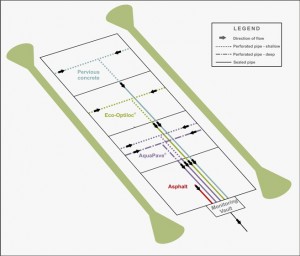Five-Year Evaluation of Permeable Pavements – Kortright Centre, Vaughan, Ontario
This five year study of the performance of different types of permeable pavements was undertaken in two phases between 2010 and 2015 on the visitor’s center parking lot at the Living City Campus in Vaughan, Ontario. Phase I of this study was conducted in 2010-2012 as part of a University of Guelph doctoral research thesis, in collaboration with STEP. The study evaluated the hydrologic, water quality and functional performance of different types of concrete permeable pavements. Phase II was initiated by STEP in July 2012 and completed in December 2014, with support from the Cement Association of Canada and the Interlocking Concrete Pavement Institute. This phase of the study extended the earlier study with a focus on evaluating the long term performance of the pavements and documenting the direction and magnitude of changes in performance over time.
The research facility consists of four pavement plots, each with an area of approximately 230 square metres. Two cells are constructed with permeable interlocking concrete pavers (AquaPave® and Eco-Optiloc®), one cell is constructed with Pervious Concrete and one cell is constructed with traditional asphalt. Click the image on the right to open a larger view of the study site.
Subsurface drainage from each plot is conveyed separately in sealed pipes to a monitoring vault where flow rates, volumes and water temperature are measured, and samples for water quality analysis are collected. The AquaPave® plot contains a lower trench and custom drainage system specially designed to evaluate the potential impact of stormwater infiltrated through native soils on groundwater quality.
The effectiveness of different maintenance practices was also assessed both on site and at older permeable pavement sites that are clogged, or are starting to show signs of clogging. Multiple types of proprietary street cleaners as well as small scale vacuuming and pressure washing on different types of permeable pavements were examined.
Study results have been used to refine policies and guidelines on the appropriate use and design of permeable pavements for stormwater management.




